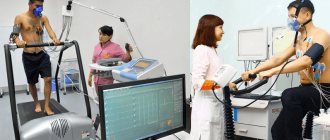© Author: Z. Nelly Vladimirovna, doctor of the first qualification category, especially for SosudInfo.ru (about the authors)
A regular cardiogram recorded at rest can diagnose previous myocardial infarction, chronic coronary insufficiency, arrhythmias and blockades. Meanwhile, it provides little information during the latent course of certain pathological conditions of the heart (certain forms of coronary insufficiency, impaired excitability and conduction), that is, the ECG does not reveal hidden heart failure that manifests itself during physical exertion.
In such cases, various functional tests with dosed stepwise increasing loads are often used, for example, a functional diagnostic method such as bicycle ergometry (VEM), which is popularly called simply “bicycle”. This is a rather apt name, since the examination device is indeed very similar to a vehicle familiar from childhood. Although a bicycle ergometer is even more reminiscent of an exercise bike, which has the ability to provide physical activity in a strictly defined dose.
The essence of the study and what it shows
VEM in cardiology is a special diagnostic method, a provoking test designed to identify hidden ongoing pathological processes. Since such problems do not manifest themselves without special conditions, extreme measures have to be taken.
Ergometry is based on provoking symptoms of a possible disease. As part of the diagnosis, doctors use a special device. It resembles a bicycle, although in a rather truncated form, due to the needs of the examination.
The patient must pedal. All this time, the heart rhythm and other vital signs, blood pressure and the number of respiratory movements per minute are monitored by special sensors.
As soon as a person feels worse and symptoms of the disease appear, the study is stopped.
Based on the diagnostic results, a group of pathological processes can be detected:
Cardiac ischemia
A chronic disorder based on insufficient blood supply to the myocardium. Which means nutrients and oxygen.
Gradually, the intensity of the manifestations becomes stronger, but in the early stages the changes are not obvious and not noticeable without a provoking test.
Attention:
Bicycle ergometry is extremely dangerous in advanced forms. Therefore, obvious signs of a violation are an absolute contraindication to research.
Angina pectoris
Especially stable. It differs in that it manifests itself only if there are special conditions. For example, a jump in air temperature, sudden physical activity. Without equipment, it is difficult to detect pathology.
The development of an angina attack is based on a sharp, rapid disruption of myocardial trophism. The coronary arteries narrow and cannot pass enough blood. It's not a heart attack yet, but it's close. Therefore, bicycle ergometry is prescribed as early as possible. Signs of a pre-heart attack condition are described in detail in this article.
Unstable angina does not require special instrumental examination. Routine methods are enough. In addition, with such a disorder, ergometry is dangerous.
Sick sinus syndrome
Chronic functional impairment. It occurs against the background of complete well-being of the body. Formally, neither an ECG nor an ECHO can even suspect a violation. Except in rare cases. It is congenital, less commonly acquired (read more about the disease here).
As a rule, against the background of SSS, the heart rate does not increase at all or increases slightly, despite the load. The intensity of physical activity, the stimulus, clearly does not correspond to the body's response.
Such a condition cannot be underestimated. Because serious complications are possible: up to a stroke and other disorders. Because the heart does not pump enough blood at the time the body needs it.
Pathologies of the lower extremities
An unexpected finding, but quite common in clinical practice. This is not why bicycle ergometry is performed. It's more about an incidental discovery or suspicion.
After the examination, the patient experiences numbness in the legs and walks poorly. Objective signs of venous insufficiency or other abnormalities are also detected: blueness and paleness of the skin, a drop in local temperature.
In this case, the patient is referred for consultation to a phlebologist or vascular surgeon.
Cardiac conduction disorders
Deviations in the functioning of the His bundle and other structures. These are the thinnest branched nerve fibers. They are responsible for moving the impulse from the sinus node to other structures and chambers.
Conduction disturbance is manifested by the fact that the frequency of contractions as the load increases does not increase at all or does not increase enough, and in advanced cases it even begins to fall. This is fraught with cardiac arrest.
Therefore, the technique is not recommended for this category of patients. Too dangerous.
Read more about the right bundle branch block here, and the left one here.
Breathing disorders
They are again discovered by chance. As a rule, they accompany the main cardiac diagnosis. Based on the nature of the deviations, certain conclusions can be drawn. But you need to examine all levels at once: heart rate, blood pressure and respiration.
Of course, bicycle ergometry alone is not enough to diagnose these diseases.
Deviations of the functional plan can be interpreted in different ways. Sometimes identical symptoms occur in different pathologies. And there are many “candidates” for the role of diagnosis.
Auxiliary techniques come to the rescue. Cardiologists draw conclusions based on the results of a comprehensive examination.
Tips for passing (for patients)
The need to come in clothes special for this purpose, which do not restrict movement, to ensure the necessary load, since an incorrectly chosen wardrobe can hinder movement, reduce the degree of load, or, conversely, increase it.
Since during the procedure you need to pay attention to the most vulnerable areas in the electrode - amplifiers - recording system, one of which is the place of contact of the electrodes with the human skin. From this it is clear that preparing the skin for bicycle ergometry is no less important. Thus, before the procedure, the patient is usually recommended to shave the areas where electrodes will be applied during the procedure. In this case, it is necessary to be extremely careful to avoid damage to the integrity of the skin and its irritation.
Before starting the procedure, wipe the shaved areas with a concentrated alcohol solution and wait until they dry. After drying the treated areas, these areas are highlighted with a special pencil and gently wiped with fine sandpaper or other rough material, for example, special disposable exfoliating graters, microabrasive strips, tampons with a special gel with microparticles.
When these recommendations are followed, the resistance of the skin is reduced to optimal, namely 5000 Ohms or less. It should be remembered that the most modern ones, such as disposable electrodes, if this technology is followed, such preparation of the skin as treatment with alcohol not only does not require, but is not recommended.
In this case, this can cause an increase in skin impedance due to dehydration of its upper layer (stratum corneum). When using disposable electrodes, the skin is wiped with a damp cloth instead of an alcohol consistency, which helps degrease it and at the same time promotes hydration (attachment of water molecules to molecules or ions).
Indications
There are quite a lot of reasons for diagnosis.
- Chronic heart rhythm disturbances. Especially if other studies do not give any results. The classic situation: symptoms are present, but there are no changes on cardiography or ultrasound. In this case, it is necessary to provoke the manifestations that the patient talks about. This can be dangerous because it is unknown what doctors are dealing with.
- Ambiguous results of ECHO or ECG. There are also situations when violations are obvious, but doctors cannot say anything for sure. Because the results are unclear. Bicycle ergometry is used to obtain more accurate data, and also, in some cases, to verify (confirm) a previously established diagnosis.
How feasible it is to achieve this with the help of a “bicycle” is difficult to say. Depends on the situation. The doctor must decide.
- The need to confirm the diagnosis. A natural continuation of the previously mentioned indications. In some cases, specialists already have ideas about the patient's condition. Bicycle ergometry allows us to say more precisely how the heart works.
- Suspicions of atherosclerosis of the vessels of the lower extremities. Oddly enough, the “bicycle” is suitable for this too. During intense physical activity, leg muscles require large amounts of oxygen and beneficial compounds.
If the trophism at the local level is weakened, there is a violation of the venous-lymphatic outflow or a disorder of the arteries, this is noticeable after a VEM test.
As previously mentioned, the patient experiences leg pain and discomfort. The skin becomes pale or blue, and becomes cold. These are clear signs of pathology. Further, a specialized specialist should understand.
- Lung diseases. Associated with heart disorders. If necessary, modifications of classical bicycle ergometry are prescribed. In this case, the oxygen concentration in the bloodstream (saturation) is additionally examined.
The technique is effective in diagnosing hidden heart pathologies. Although it is certainly dangerous and carries risks to life. It also has another area of application.
Bicycle ergometry is used for therapeutic purposes, usually among athletes.
“Bicycle” solves two problems:
- Trains the body. Because the intensity of the load is quite high. In addition, it can be dosed as the situation requires.
- Helps to rehabilitate faster. After injury or a long break from training.
Methodology
The sequence of actions when conducting a test is as follows:
We recommend reading the article: ECG signs of angina pectoris
- Before testing, blood pressure and resting ECG readings are taken.
- Electrodes are attached to the patient's chest to take an electrocardiogram, and a tonometer cuff is placed on the shoulder to record blood pressure readings.
- He begins to pedal the bicycle ergometer with minimal intensity. The load will increase in steps every two to three minutes.
- During the procedure, changes in the heart cardiogram and blood pressure readings are recorded.
- The patient should tell the doctor about any discomfort that occurs during exercise, even if it is minor.
- When a certain level of heart rate and blood pressure is reached, when pain appears, changes in the ECG or increased discomfort, the patient stops pedaling, but the result continues to be recorded for another ten minutes so that the doctor can assess how the recovery is progressing.
Contraindications
Bicycle ergometry is not always performed for obvious reasons. For many patients, it is not prescribed due to the critical danger to life and health. Among the reasons:
- Unstable angina. It is a special case of coronary insufficiency. Symptoms occur spontaneously. Spasm of local arteries is observed. Those that nourish the myocardium. As a result, the quality of trophism is rapidly declining.
Each such episode is an acute violation. It is not known when the irreparable will happen. Ergometry itself can provoke an emergency condition. Therefore, it is not prescribed to this category of patients. Even if the disease is at an early stage.
- Previous heart attack. The essence of the process is the death of the tissues of the muscular organ and their replacement with dense, scar tissue. Accordingly, it can no longer work as before.
Regardless of how long ago the acute episode occurred, bicycle ergometry is not performed. It’s too dangerous because there is a high risk of the negative scenario repeating itself. Cardiac arrest is also possible.
- Suspicion of a heart attack. In this case, there is no evidence, but the hypothetical risks are so great that doctors prefer to use other examination methods.
- Heart defects. Especially the valve system. Aortic stenosis, as an example. When the cusp at the exit of the largest artery does not allow enough blood to be ejected.
In such a situation, the useful volume of circulating fluid connective tissue is too small to supply the body even at rest.
Need I say what threatens such a patient when the tissue demand for oxygen and nutritional compounds increases?
- Arrhythmias. Heavy. Paroxysmal tachycardia, multiple extrasystoles, also atrial and ventricular fibrillation. Dangerous types of arrhythmia completely exclude the possibility of bicycle ergometry. Otherwise, cardiac arrest will occur.
- Myocarditis. Inflammation of the muscle layer of the organ. Usually of infectious origin. During this period, work wears out. A slight shock is enough to provoke at least the death of a large area of tissue. At the very least, the organ may simply not be able to withstand it.
- Pericarditis. Another dangerous condition. It is an accumulation of fluid or blood in a special sac that covers the outside of the heart and does not allow it to move. This is the so-called pericardium.
The patient needs to be treated faster. No time for research. Not just for ergometry, but even for a deep check using an ECG.
If the fluid pressure on the organ becomes equal or close to that inside the muscle structure, a stop will occur. Most likely, the patient will not be returned. Therefore, there is no talk of any instrumental research.
- High blood pressure levels. Advanced hypertension. “Bicycle” increases blood pressure. This is an inevitable effect. And therefore, the technique is contraindicated in patients with chronic disorders of vascular tone. It doesn’t matter whether it’s in a compensated form or another – bicycle ergometry is contraindicated for hypertensive patients.
- Pulmonary embolism. Blockage of the structure by a thrombus. This condition is not always absolutely fatal. At least, it does not immediately provoke death from complications. It all depends on the diameter of the clot. It is important to remove the foreign structure from the vessel. If there are suspicions or the disorder has already been proven, bicycle ergometry should absolutely not be done.
Attention:
An ergometer is a rather dangerous device; in most cases, doctors play it safe and do not prescribe a test. They resort to it only if there is no way out.
Complications after the study
Despite the fact that electrocardiographic studies during bicycle ergometry are recognized as quite effective methods for studying disturbances in the functioning of the heart and blood vessels, it is not carried out so often and is mainly used in such a category as athletes to determine the possible load they can tolerate.
This is due to the fact that during the study the subject needs to achieve the maximum maximum load exerted on the body, which is usually acceptable for athletes, but not for patients suffering from various diseases.
This method is used in patients only if the risk of performing bicycle ergometry is justified by other studies and it is not possible to identify deviations from normal heart function. Since bicycle ergometry is carried out while providing a large physical load on the body, this can provoke additional manifestations of disturbances in the functioning of the heart and blood vessels.
The most common complications after bicycle ergometry include the following manifestations:
- as the formation of a hypertensive crisis,
- myocardial infarction,
- paroxysmal rhythm disturbances (atrial fibrillation, ventricular tachycardia).
Heart rhythm disturbances such as flutter and/or ventricular fibrillation may also occur.
In addition, during the study, when performing a load, the subject may lose consciousness, especially if he has previously undetected lesions of the carotid and cerebral arteries, which are usually the consequences of atherosclerosis and hypertension.
But you should not refuse to perform bicycle ergometry. Since it is usually prescribed to patients rarely, and only when necessary, when it was not possible to establish disturbances in the functioning of the heart in any other way. If the attending physician makes a positive decision regarding performing an ECG with stress, then the patient must undergo the procedure, since this means that the doctor has a sufficient number of justifications for this.
It should be noted that complications during electrocardiographic examination are very rare.
The specialist conducting the examination during bicycle ergometry carefully monitors the subject, constantly measures pressure, monitors ECG readings, and in case of the slightest complications, decides to interrupt the examination procedure.
In addition, the examination itself is based on the method of slowly gradually increasing load, which allows you to constantly monitor the condition of the subject and, if necessary, stop the examination in a timely manner without thereby harming the patient.
Preparation
To reduce risks and at the same time increase the accuracy of the examination, it is enough to follow a number of recommendations.
- Quit alcohol and smoking for 24 hours. Ethanol and substances contained in cigarettes affect vascular tone. A spasm occurs. Narrowing of the lumen of the arteries. This will inevitably affect the functioning of the heart. At a minimum, with a minimal increase in load, arrhythmia will occur and blood pressure will increase. Is it dangerous. The study will have to be interrupted.
- The same goes for coffee and strong tea. It is better to leave tonic drinks for later. By the way, heart patients should avoid them altogether. In order not to provoke dangerous symptoms, do not increase risks.
- Several hours before the procedure, you should not overexert yourself physically. Otherwise the results will be false from the start. Plus, the likelihood of complications and undesirable consequences after bicycle ergometry increases.
- They refuse food within 2-3 hours. Food and the digestion process increase the load on the muscular organ. It's too much.
- Clothes need to be chosen according to the situation. It should not be constraining or uncomfortable. Otherwise it will be unpleasant to move. It will take effort to cope with the resistance of the clothing. This is an extra burden that will definitely affect the diagnosis and its results.
- On the recommendation of a specialist, the patient refuses certain medications the day before bicycle ergometry. You cannot cancel anything on your own. Too dangerous.
If you follow these recommendations, the HEM test will be safer and more effective.
Research stages
They start by examining the person and recording his indicators:
- at rest;
- when a load is placed on it;
- the entire period it took him to recover.
This technique is recognized as the most effective and allows the most complete assessment of:
- human capabilities;
- his heart and blood vessels, as well as their condition.
This is usually due to the fact that with increased physical activity, the work of the heart increases, which provokes the need for it to consume large amounts of oxygen.
Measuring blood pressure
The heart without pathologies is able to calmly respond to physical activity, even if the person being examined is very tired, it does not experience severe discomfort. The displayed heart parameters show indicators corresponding to the normal functioning of a healthy heart. But the heart, conventionally called weak, quickly gets out of the norm, changing its indicators, which is also immediately recorded on the electrocardiogram.
Thus, the bicycle ergometry technique consists in the most complete and comprehensive study of the activity of the state of the cardio-respiratory system, at rest, during physical activity and after it. This helps to obtain the most complete clinical picture, in contrast to similar research methods, but without physical activity.
Progress of the procedure
An approximate algorithm is:
- The patient arrives at the clinic at the appointed time.
- Special sensors are placed on the chest, the function of which is to record heart rate. At the same time, in addition to monitoring the ECG, specialists monitor blood pressure and respiration.
- The procedure itself begins. The patient should pedal at an average pace, then the intensity of the load is increased. They do this gradually and in extremely measured doses, so as not to cause harm on the one hand, and on the other hand to accurately determine the moment when disturbances begin.
- As soon as the patient feels discomfort and the sensors detect decompensation of the heart, the study is stopped. This is the goal that diagnosticians strive to achieve.
Throughout the event, the patient talks about his condition. This is important so as not to miss the moment when you need to stop the procedure. Everything takes from 10 to 20 minutes. Rarely more.
Conditions
Bicycle ergometry cannot be performed earlier than two hours after breakfast.
The test is carried out under the supervision of an experienced cardiologist who knows the patient’s medical history and the indications for the procedure. The room must be equipped with all the necessary equipment in case of resuscitation. The air temperature in it is from 18 to 20°C.
Constant monitoring of the well-being and appearance of the subject is carried out. Changes in the electrocardiogram are monitored using an oscilloscope. Heart rate and blood pressure are regularly recorded.
The pedaling frequency should be approximately 60 revolutions per minute (from 40 to 80).
The load is assessed by blood pressure, heart rate, ECG, and oxygen consumption. Tests with maximum load can only be performed on healthy people.
Decoding and interpretation of results
All results are reflected in the study protocol. Key indicators that interest specialists:
- Initial heart rate. How many beats per minute there were at the beginning.
- Final heart rate. Quantity at the end of the procedure.
- ECG indicators. All segments and teeth are taken into account.
- Duration of the examination.
- The maximum load at which the peak occurred.
- Reason for stopping bicycle ergometry.
Deciphering and interpretation are carried out both by specialists on site and by a cardiologist, who will examine the results himself. You won’t be able to evaluate the indicators on your own. Because there are too many of them, and there are even more nuances during interpretation.
Interpretation of VEM results
Hardware data includes parameters such as:
- patient's performance level;
- heart rhythm, detected disturbances (if any);
- rate of recovery of blood pressure and heart rate;
- type of blood pressure response to exercise;
- severity of ischemia;
- time and reason for stopping testing, etc.
After interpretation of the data, the patient is given a conclusion.
There are 4 main forms of conclusion:
Negative VEM test - when the maximum load was reached, normal physiological parameters were preserved. IHD is excluded in most cases.
A positive result —the ECG shows changes indicating ischemia, often accompanied by an attack of angina.
A questionable result —the subject complained of pain, but there were no changes on the ECG.
Uninformative test - the study was not completed completely, the patient refused to continue testing due to dizziness, severe headache or convulsions, although there were no signs of coronary artery disease.
Despite all the information value of bicycle ergometry for most patients, the uncertainty of the results of a particular test may require the appointment of additional studies.
Decoding the treadmill test is practically no different from deciphering the VEM results. Normal indicators for the treadmill test, as well as the VEM test, are negative indicators.
Analogues of the method
A bicycle ergometer is not the only possible stress test. There are other options:
- Treadmill. A treadmill is used for diagnosis.
- Step technique. Doctors use special steps. The patient's task is to step up and down.
Both options are also quite dangerous. The only difference is in the technique and the likely end result. What to prescribe is decided by a specialist.
VEM test or bicycle ergometry is a loading technique for studying the functional state of the heart. It is used in extreme cases, if other methods have not given a clear answer to the question of what is happening.
It is important to consider contraindications and possible risks. Relate them to the likely benefit. Because the technique is dangerous.











